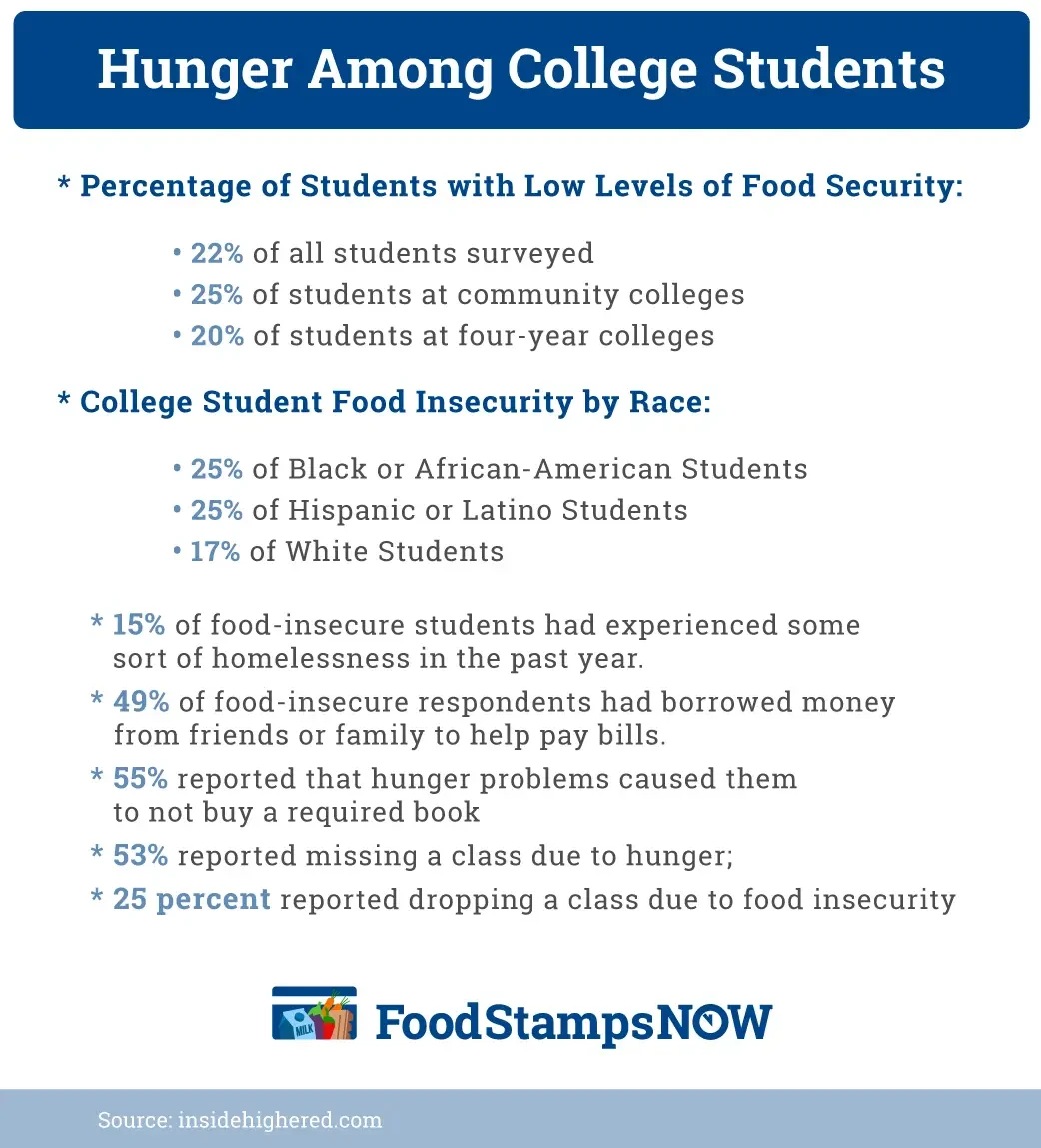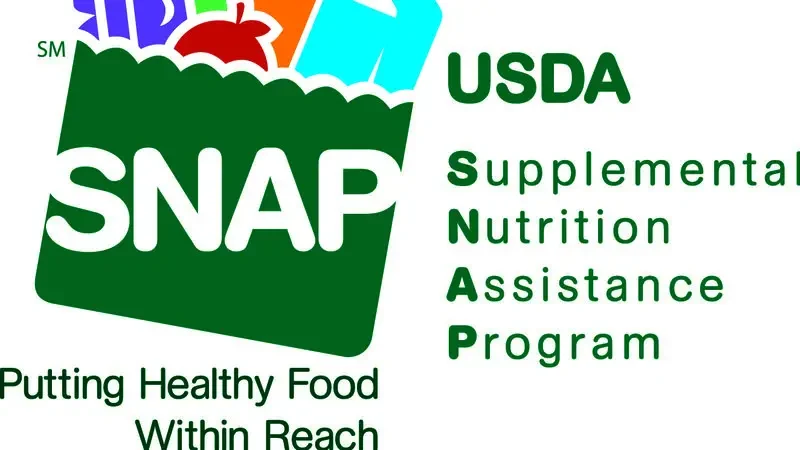If you are a college student, your biggest source of stress should come from school work and perhaps how soon you can graduate. What you should not have to worry about is where your next meal is going to come from. Unfortunately, a growing number of college students are going hungry every day and this has been going on for a while. If you are a student and can’t afford to buy food, you may qualify for food stamps for college students.
In this post, we will explain in detail how the food stamps program (also known as SNAP) works and who can apply.
Our goal is to answer in detail the most common questions we get from students about food stamps.
After reading this article, we want you to be equipped with all the relevant information you need to submit a successful application for food stamps.
We will also look at how the eligibility guidelines affect full time versus part-time students. Finally, we will review how student loans and financial aid can affect food stamps for college students.
More Students are Going Hungry
According to a recent report published by NPR, researchers at Temple University and the Wisconsin HOPE Lab found that more than a third of college students surveyed reported they don’t always have enough to eat.
In addition, 37 percent of community college students and 29 percent of four-year students reported that the food they purchased did not last and they did not have money to buy more.
Another survey, published in the San Francisco Chronicle looked at hunger among students at the University of California.
This 2015 survey of 9,000 students across all 10 campuses provided more insight into this growing problem.
It revealed that nearly 1 in 5 students, 19 percent, said they had too little to eat because they could not afford to buy food. Another 23 percent routinely ate substandard food.
The image below paints a complete picture of Hunger Among College Students.
Causes of Food Insecurity Among College Students
There are several factors that are causing the rise of food insecurity among college students.
Rising Tuition and Fees
First, while tuition and fees continue to rise, financial aid hasn’t kept pace. This is creating a strain on student budgets.
For example, during the 2017-18 school year, on average, full-time students at two-year colleges had to pay $8,070 in room and board, while those at four-year public institutions had to cover $14,940 in room, board, tuition, and fees.
This means that students are left with little money for food, especially those that have to work to cover their portion of tuition and fees.
Rising Cost on Campus
Second, the high cost of housing and food on some college campuses has caused some students to go hungry because they cannot make enough money to keep pace.
Meal plans on some campuses can be very expensive, as much $6,000 for one academic year in some cases. This is out of the reach for many students.
The University of California at Berkeley Survey
A deeper dive into data for the University of California at Berkeley (UC Berkeley) demonstrated this growing problem.
Between January 1st and February 14, 2017, more than 500 UC Berkeley students had applied for food stamps, up from 111 in all of 2016, and just 41 in 2015.
The problem is so alarming that representatives from a local food bank, who used to show up on campus once a month to help the students apply for food stamps now have to come every week to meet the need.
While not all UC Berkeley students who applied qualified, the acceptance rate was 73 percent in 2017, up from 62 percent in 2015.
Food Stamps Eligibility for Students
The United States Department of Agriculture (USDA), which administers the food stamps program at the federal level has guidelines that states must follow regarding students who apply for food stamps.
Each state is also allowed to create additional eligibility requirements that meet their unique situations.
To find out if you are eligible for food stamps as a college student, you first have to determine if you are considered a student for food stamps application purposes.
Who is a student?
You are considered a student for food stamps application purposes if you are:
- Age 18-49 and is physically and mentally “fit” for employment.
- Enrolled at least half-time in regular curriculum at an institution of higher education in which the regular curriculum meets the standard requirements for graduation or certification in a particular field of study.
Note that the term “Half-time” is determined by the institution in which you are enrolled.
For this purpose, an institution of higher education is a business, trade, a technical or vocational school that usually requires a high school diploma or GED; or a junior, community, two-year or four-year college or university, or graduate school.
Who is not a student?
The food stamps student eligibility rules do not apply to people who are:
- Age 17 and under or age 50 and older, OR
- Physically and mentally “unfit” for employment, OR
- In high school, OR
- Enrolled less than half-time, OR
- Enrolled in programs or classes that do not require a high school diploma or GED, OR
- Enrolled in schools that are not considered institutions of higher education.
Students Who Can Apply for Food Stamps
You can apply for food stamps for college students if you meet one of the following criteria:
- You work at least 20 hours per week; OR
- You currently take part in a State or federally financed work study program; OR
- You are a parent or caregiver; OR
- You are currently receiving TANF benefits; OR
- You are enrolled in certain programs aimed at employment.
Note that states have the flexibility to designate what counts as employment and training programs. In California, for example, students who participate in certain educational programs at school are eligible for food stamps.
You should, therefore, check with your state’s agency that runs the food stamps program to get details about state-specific eligibility rules.
See below for a link to state-specific food stamps websites for more information.
Rules for Student who are Non-Citizens
Undocumented non-citizens and non-citizens with temporary status, including those on student visas, are not eligible for food stamps.
In addition, students granted Deferred Action for Childhood Arrivals (DACA) are also not eligible for food stamps.
However, non-citizen children under 18 who are “qualified immigrants,” are eligible without a waiting period.
Finally, non-citizen adults who are “qualified immigrants,” such as Lawful Permanent Residents (LPRs), are typically subject to 5 years waiting period.
Contact your state’s food stamps administrator for more details regarding rules for non-citizen students (see links to state-specific food stamps websites below).
Tip on How to Apply for Food Stamps
Applying for food stamps as a college student can be a stressful experience for many.
That’s because the rules can be complex and students who need help now tend to shy away from applying for food stamps since they think it’s too complicated and takes too long to get approved. We can help.
If you need food stamps right away and don’t know what to do, here are some tips to help you navigate the process successfully:
First, check to see if you qualify for food stamps. The best way to do that is to reach out to a local food bank that helps individuals get food stamps.
They will take a look at your situation, including your income and can tell you with a high level of certainty if you qualify for food stamps. That will save you a ton of time and frustration.
Google “local food banks” in your area. Call as many as necessary to find out which ones help with food stamps application.
Food Stamps Income Limit
The most important criteria in determining whether you are approved for food stamps is whether you meet the income limit.
To qualify, your gross monthly income — that is, income before any of the program’s deductions are applied — generally must be at or below 130 percent of the poverty line.
States are allowed to raise the gross income limit above this level. You should check with your state’s food stamps agency to see if there is a different gross income requirement.
Net income, or income after deductions are applied, must be at or below the poverty line unless the household has a member over age 60 or getting major disability benefits like Social Security or SSI.
The image below shows the current food stamps income limit according to the USDA.
Does Financial Aid Count As Income?
If you are receiving Federal financial aid like Pell grants, Perkins loans, and Stafford loans, they DO NOT count as income or assets for food stamps benefits.
In addition, work-study earnings do not count as income.
Also, non-federal financial aid used for anything other than living expenses is not counted as income for food stamps purposes.
Finally, other financial aid, including deferred payment loans and veterans’ educational benefits, are not counted as long as it is used to pay for educational expenses, including tuition, books, and required fees.
Will Getting Food Stamps Affect my Financial Aid?
This is one question we get a lot from our student readers. No, your food stamps benefits will not be treated as income when calculating expected family contribution (EFC) for financial aid.
When you complete the FAFSA and report that you are getting food stamps or other benefits, you will be eligible for a simplified needs analysis that does not require you to report family assets.
In addition, if you are a student on food stamps and have family income under $24,000, you qualify for an automatic zero EFC and more financial aid.
Do Students Have to Report Parents’ Income?
When applying for food stamps as a student, the income and assets of your parents who do not live with you are not counted.
However, if your parents or others provide you with ongoing support, that support may need to be reported as income unless it is clearly a loan.
Also, if you are a student and live with your parents, and are at least 22 years old, and buy and prepare at least half of their meals independently, they can apply as a separate household.
Note that students ages 18-21 who live with their parents can only apply as part of their parents’ household.
What if I Don’t Qualify for Food Stamps?
If you don’t qualify for food stamps, there are plenty of other resources available to you to meet your nutrition needs as a student.
Food Banks Can Help
The first is to reach out to a local food bank. Food banks are great at meeting the immediate needs of people who need food assistance now.
Most people are embarrassed or have a stigma attached to food banks. However, 1 in 7 people in the United States relies on food banks to meet their nutrition needs.
One reason is that food banks are welcoming and their sole mission is to make sure no one goes hungry. So, if you are not able to afford all the food you need, why visit the organizations in your area whose sole mission it is to make sure you get the nutrition you need?
Google “local food banks” in your area. Call as many as necessary and visit their locations to check them out. You will be surprised to see how welcoming and helpful they are.
University or College Run Programs
Second, your own school may have a program that could help you get food assistance even if you don’t qualify for food stamps.
For example, in California, students at UC Berkeley who don’t qualify for food stamps can get help from a university-sponsored food assistance program.
Call your dean’s office or school administration and find out if your school has resources to help students who need food assistance or if the school can refer you to programs in your state that help needy students with food assistance.
Student-Run Organizations
Third, student-run programs like National Student Campaign Against Hunger and Homelessness can help you find resources that can help you get the food you need.
This can also be a way for you to stay involved with the push to end hunger on college campuses.
Apply for Food stamps for College Students
If you qualify for food stamps as a student, you must apply in the state where you are enrolled in school. Click on the state where you are currently attending school to apply. Once on the state website, look for SNAP or Food Stamps/Food Assistance application.
-
-
- Alabama
- Alaska
- Arizona
- Arkansas
- California
- Colorado
- Connecticut
- Delaware
- District of Columbia
- Florida
- Georgia
- Hawaii
- Idaho
- Illinois
- Indiana
- Iowa
- Kansas
- Kentucky
- Louisiana
- Maine
- Maryland
- Massachusetts
- Michigan
- Minnesota
- Mississippi
- Missouri
- Montana
- Nebraska
- Nevada
- New Hampshire
- New Jersey
- New Mexico
- New York
- North Carolina
- North Dakota
- Ohio
- Oklahoma
- Oregon
- Pennsylvania
- Rhode Island
- South Carolina
- South Dakota
- Tennessee
- Texas
- Utah
- Vermont
- Virginia
- Washington
- West Virginia
- Wisconsin
- Wyoming
-
Our goal with this article was to equip students with all the information they need to successfully apply for food stamps for college students.
If you qualify for benefits but were unable to get food stamps, or you had issues submitting an application, we would like to know so we can look into it. Tell us in the comments section below.
If you have any tips or advice for other students who need nutrition assistance or are in the process of applying for food stamps for college students, feel free to share them below.




